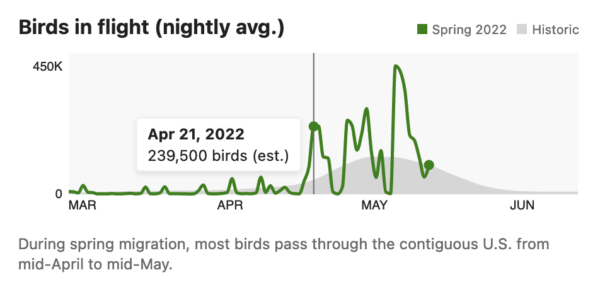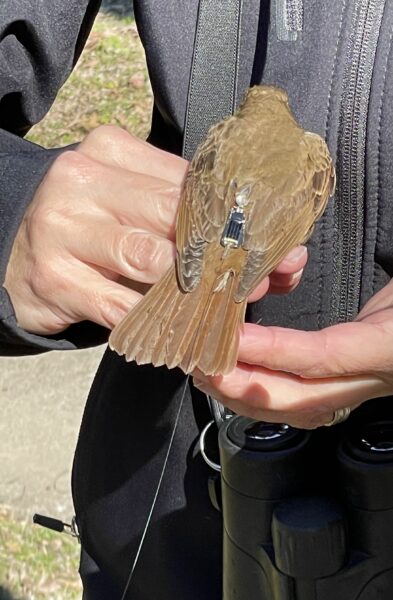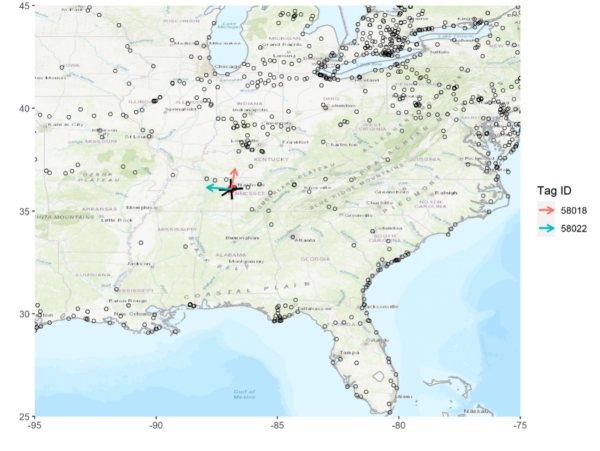The recent release of the BirdCast Migration Dashboard inspired much excitement here at BirdCast Central and among the broad array of collaborators, colleagues, friends, family, and followers. There are many ways to apply the information you can explore with the dashboard, but one intriguing possibility comes to us from Laura Cook of the amazing Warner Park Nature Center in Nashville, Tennessee. Take it away, Laura!

The BirdCast Migration Dashboard for Davidson Co., TN shows the first big movement of this spring’s migration period on 21 April 2022.
Here, at Warner Park Nature Center in Nashville, Tennessee, we love this time of year – the tapestry of wildflowers is breathtaking, every possible shade of green is glowing from the trees, and its peak migration time! We especially love migration at our public banding station where we have the opportunity to contribute to the broader understanding of birds while inspiring park visitors about the importance of birds and their habitat, and the numerous actions they can take to help birds.
BirdCast, with its new Migration Dashboard, is the first thing we view each morning throughout migration season. During our Spring NatureFest last weekend, we were able to share with our 450 guests that over 2,385,300 birds had crossed our county the previous night – mind-blowing and educational for most of our park visitors!

A Hermit Thrush with a Cellular Tracking Technologies Hybrid LifeTag transmitter about to released at the Warner Park Nature Center Bird Banding Station. These radio-tags transmit on 434 HGz frequency and are solar powered with a rechargeable battery that allows them to transmit 24 hours a day.
To complement our long-term banding efforts, the Warner Parks BIRD Program joined Motus Wildlife Tracking System network (see below) in 2020 by installing a dual 434/166 MHz radio receiver station at the nature center and launched a research project on five species of thrushes to better understand habitat use and the role Warner Parks may play in migration stopover. Our targeted thrush species for this study include breeding Wood Thrush (Hylocichla mustelina); migrating Swainson’s Thrush (Catharus ustulatus), Gray-cheeked Thrush (Catharus minimus), Veery (Catharus fuscescens); and wintering Hermit Thrush (Catharus guttatus, check out the species’ eBird status & trends map here).
Hermit Thrushes winter in Middle Tennessee and in fall 2020 we radio-tagged two with Cellular Tracking Technologies (CTT) LifeTag radio transmitters, which we monitored with our receiver stations. To our delight both birds spent the winter with us, departing on 16 February 2021 and 07 April 2021. In fall 2021, we radio-tagged three Hermit Thrushes with CTT Hybrid LifeTags.
Again, all three Hermit Thrushes spent the winter with us. One Hermit Thrush was no longer detected after 06 March 2022. But by mid-April, the other two thrushes (37420 and 37463) were still being detected each day by our receiver stations and we wondered when they would depart (see below, Table 1).
Spring migration in Middle Tennessee seemed slow this year, and BirdCast confirmed this, with the first big migration push on 21 April 2022 with 2,385,300 crossing our county that night.
To our amazement, that was the same night our two remaining Hermit Thrushes departed at 0130 UTC (8:30pm CDT) and 0345 UTC (10:45pm CDT).

Both Hermit Thrushes departed 21 April 2022 just 2 hours apart after spending the winter. Departure event illustrated thanks to Motus.org
And regarding another of those species I mentioned previously in this post: Wood Thrushes are now singing at Warner Parks and so far this spring, we have deployed CTT Hybrid LifeTags on three of them. How long will they stay, and will they depart in the fall during a big migration night? We have so much to learn and are grateful to BirdCast, Cellular Tracking Technologies, and Motus for providing the cutting-edge tools to help us better understand bird migration and share the wonder of birds with our park visitors.
The Motus Wildlife Tracking System (hereafter Motus: Latin for movement or motion) is a collaborative global network of projects using automated radio telemetry to track small flying organisms (birds, bats, and insects). Motus collaborators primarily undertake research and education related to the ecology and conservation of migratory animals. Motus enables the tracking of the smallest animals possible with high spatiotemporal precision at local, regional, and even hemispheric scales. Motus is a program of Birds Canada in collaboration with a diverse network of individuals, organizations and businesses.
Motus uses digitally-coded radio tags that emit signals on coordinated frequencies, detectable at ranges of up to 20km by an open-source network of automated receiving stations. This enables thousands of animals of hundreds of species to be tracked simultaneously. Irrespective of where an animal has been tagged, be it northern Canada or southern Chile, all data are processed centrally and returned to collaborators and make viewable to the public. Participants in the network set up receivers and deploy tags for their own purposes, and in doing so leverage the time and effort of other users, with mutually reciprocal benefits. Motus collaborators currently maintain more than 1300 stations in 31 countries across 4 continents, and has tracked more than 31,000 individuals of close to 300 species (including >80 species of conservation concern in the western hemisphere), from which >150 peer-reviewed journal papers and theses have been published. This coordinated, altruistic coalition expands the scale and amplifies the impact of everyone’s work, and optimizes the value for research and conservation
Table 1. Hermit Thrushes radio-tagged at Warner Park Nature Center Banding Station
|
LifeTag# *= hybrid |
Capture Date |
Age/Gender at capture |
Weight/Fa t |
Departure Date |
# days at Warner Parks |
|
552D5507 |
10/20/2020 |
AHY/U |
30.4g/0 |
04/07/2021 |
171 |
|
34664C07 |
11/04/2020 |
HY/U |
29.4g/0 |
02/16/2021 |
105 |
|
6607522D |
04/13/2021 |
ASY/U |
27.8g/0 |
04/25/2021 |
13 |
|
5533784C* |
10/28/2021 |
HY/U |
29.3g/0 |
03/06/2022 |
132 |
|
34071E66* |
11/09/2021 |
HY/U |
28.3g/1 |
04/21/2022 |
164 |
|
33783407* |
11/16/2021 |
HY/U |
30.8g/2 |
04/21/2022 |
152 |




